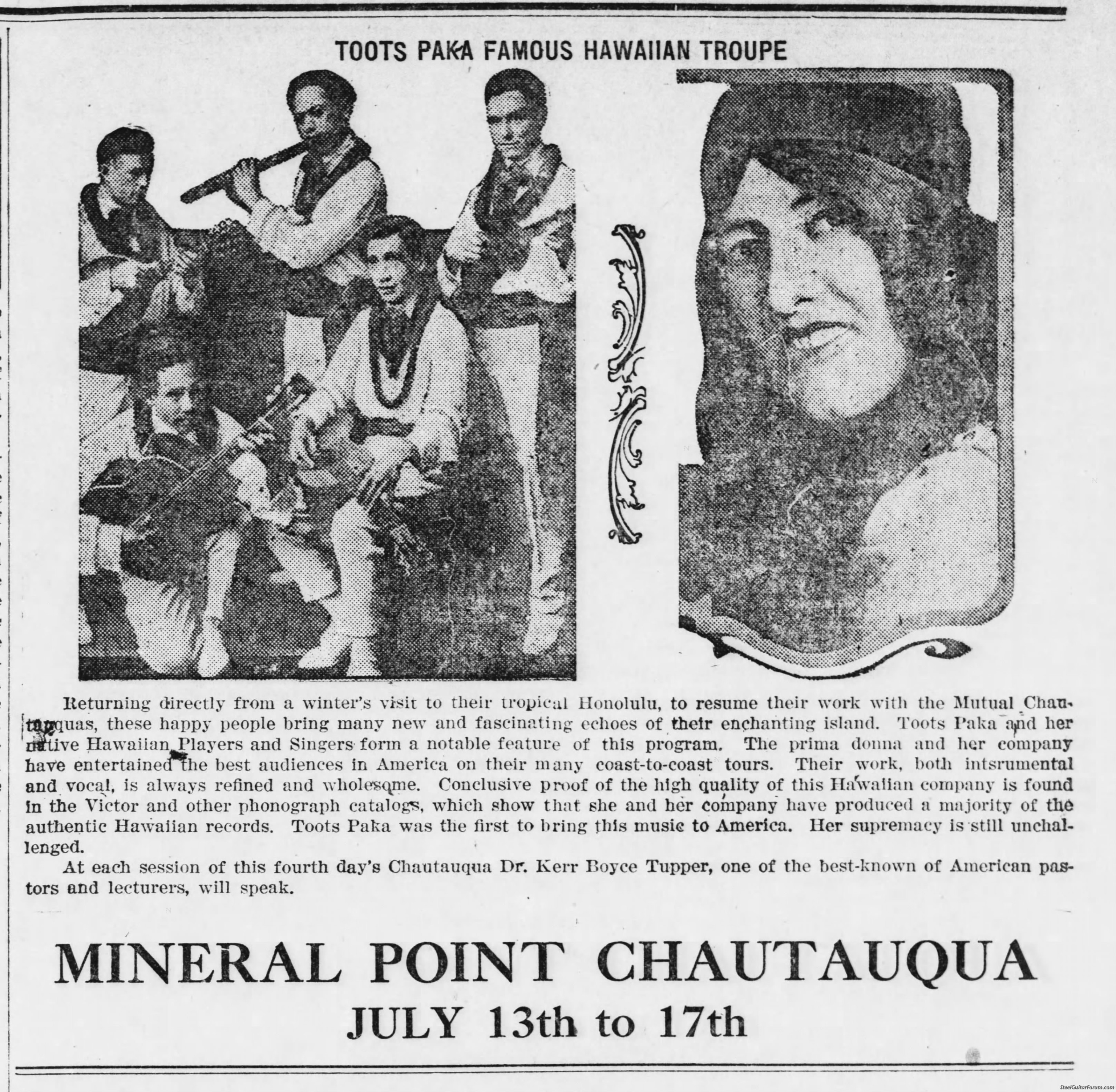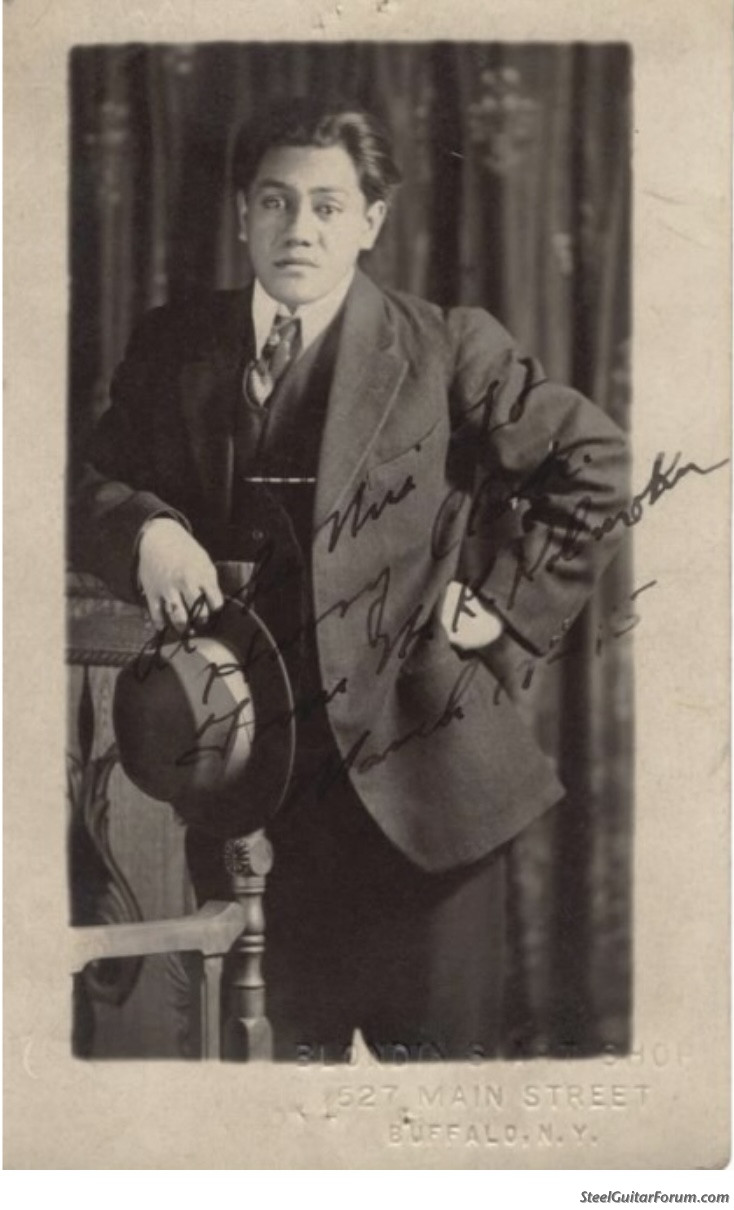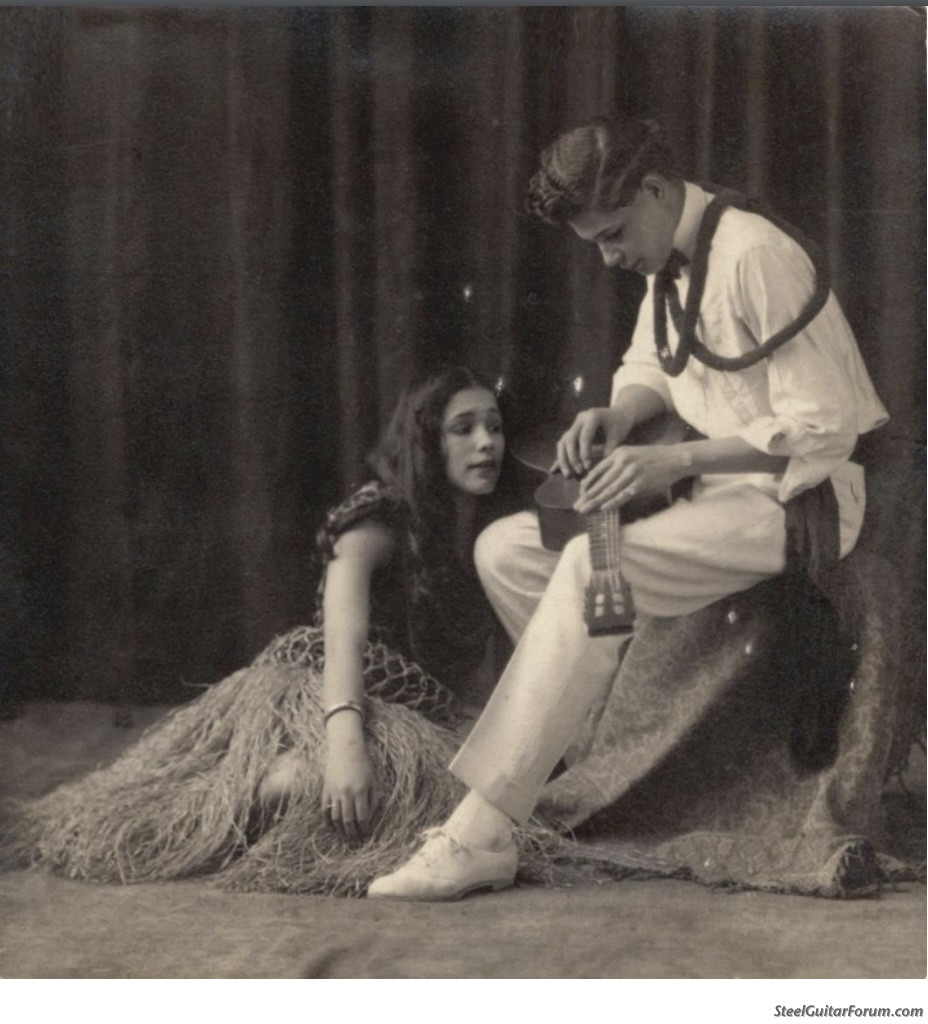robert kramer
From:
Nashville TN
|
 Posted 31 Aug 2024 3:18 am
Posted 31 Aug 2024 3:18 am |
|
This is a follow-up to John Norris's "Topic: 1930s & 40s recordings featuring Letritia Kandle found."
(The following post is a two-parter)
Part #1 "The First Steel Players to Work Nashville"
Part #2 "Moving Images of the First Steel Players to Work Nashville
Part #1 "The First Steel Players to Work Nashville"
Grand Ole Opry transcriptions from the 1950s featuring Little Roy Wiggins, Don Helms, Bashful Brother Oswald, Johnny Siebert, Uncle Josh, Jimmy Day, Buddy Emmons, and many others document steel players knocking Ryman audiences on their ears. In light of the recent boom in Nashville's entertainment industry, I thought it might be fun to go back and see and hear the very first steel players to work Nashville, native Hawaiians booked on the Vaudeville circuit from the 1900s to the 1930s. Like our modern state-of-the-art players, they also sparked downtown Nashville audiences to stand up and applaud the hypnotic sound of steel sliding across steel.
From 1909 to around 1937, at least 28 Hawaiian acts, some well-known and others forgotten, worked the 10-cent Vaudeville Theatres in downtown Nashville: The Crescent and The Fifth Avenue on 5th Avenue North, the Princess and the Loew's Vendome on Church Street, and the Lincoln on Cedar Street. They accompanied Hula Hula dancers, native singers, and one-act Island dramas. These were the days of Houdini, Charlie Chaplin, Caruso, Buffalo Bill's Wild West Show, the Ziegfeld Follies, John Phillips Sousa, and Rin Tin Tin. Hawaiian troupes shared the bill with the other vaudeville artists of the day: opera singers, philosophical lecturers, black face minstrel acts, Russian ballet dancers, acrobats, sharpshooters, stunt artists, contortionists, jugglers, tumblers, gymnasts on skates, novelty comedy cyclers, trained dog acts, whistlers, song and dance teams, cartoonists, monologists, satirists, character impersonators, animal imitators, clog and variety dancers, Irish soloists, Italian violinists, tenors, soubrettes, ragtime and classical pianists, sister harmony trios, xylophonists and marimbaphonists, one-act comedy skits, child stars, clever comedians cast as mirth producers of unsurpassed excellence, "the water nymph and her pets," two minutes with the Weegee board," "the largest elephant fiddle in captivity," and, "The "Bulletproof Lady," renowned as "The Sensational European Enigma."
The better-known and well-documented Hawaiian steel players to work Nashville were July Paka ("Toots Paka and Her Hawaiians," May 1915 & June 1916), James "Kimo" Kalohi ("Ellis Hawaiian Quintet," December 1916, May 1917, December 1917), Sam K. Nainoa ("Nainoa," June 1917), Eddie Shaw ("Jonia And Her Hawaiians," May 1918, October 1919, September 1920), Walter K. Kolomoku ("The Bird of Paradise" stage play, January 1919), Robert Matsu ("Joe Vierra's Hawaiian Troupe," May 1922).
Their live stage performances were, of course, not recorded, but we can get an idea of what they sounded from the stage like by listening to their records:
"Toots Paka Hawaiians" July Paka: stl gtr
"Sweet Hawaiian Moonlight Waltz" Brunswick 5008 - 1920 (r)
https://www.youtube.com/watch?v=mqJOnHRPuNk
July Paka: stl gtr

The Blanchardville Blade, July 1, 1920 (Blanchardville, WI)
"Smith & Kolomoku" Walter K. Kolomoku: stl gtr
"Aloha Oe Waltz Medley" Edison Blue Amberol Record 2701 - 1915 (r)
https://archive.org/details/edison-50288_01_4011
Walter K. Kolomoku: stl gtr

"Eddy Shaw's Hawaiians" Eddie Shaw: stl gtr
"Sweetheart Of The Tropical Sea" Brunswick – 4688 - 1929 (r)
https://www.youtube.com/watch?v=3N6S0GB9v4M
Sister & Brother: Jonia "Libby" Shaw, "The Pearl of Hawaii & Eddie Shaw: stl gtr

© Winifred Matteson Archive
"Kalama's Quartet," Mike Hanapi & Robert Matsu: stl gtr
"Wai O Puna Lau" / "Nu Ioka Hula" Okeh 41212 - Apr 15, 1929 (r)
https://www.youtube.com/watch?v=828e-ZY6uf0
Mike Hanapi: stl gtr (center) & Robert Matsu: stl gtr (front row -3rd from left)

As an aside: Between February 1921 and August 1929, at least seven classic female blues singers also worked Nashville's Vaudeville theatres, just blocks from where the Hawaiian troupes appeared. From 1921 to 1929, they made multiple stops in Nashville at the Bijou Theatre on 4th Avenue North and the Orpheum Theatre on 7th Avenue North: Mamie Smith, ("The Queen of the Blues"), Bessie Smith (The Empress of the Blues"), Sarah Martin ("The Famous Moanin' Mama"), Clara Smith (Queen of the Moaners"), Ethel Waters ("Sweet Mama Stringbean"), Ida Cox ("Uncrowned Queen of the Blues"), and Virginia Liston.
Mamie Smith, Bessie Smith, and Sara Martin all entertained at the Ryman Auditorium two decades before the "Grand Ole Opry" landed there. Two months after Sarah Martin worked the Ryman, she recorded for Okeh at their West 45th Street studio in New York City with Sylvester Weaver backing her on guitar. At the same session, Sylvester Weaver cut "Guitar Rag," the precursor to "Steel Guitar Rag." On Wednesday, May 26, 1926, WSM-Radio broadcast Bessie Smith's late show from the Bijou Theatre, where the Memorial Auditorium parking garage stands now. Bessie disembarked at Union Station in Nashville from her 74-foot-long custom-made Pullman coach, painted bright yellow with green lettering.
Last edited by robert kramer on 10 Sep 2024 11:56 am; edited 3 times in total |
|




